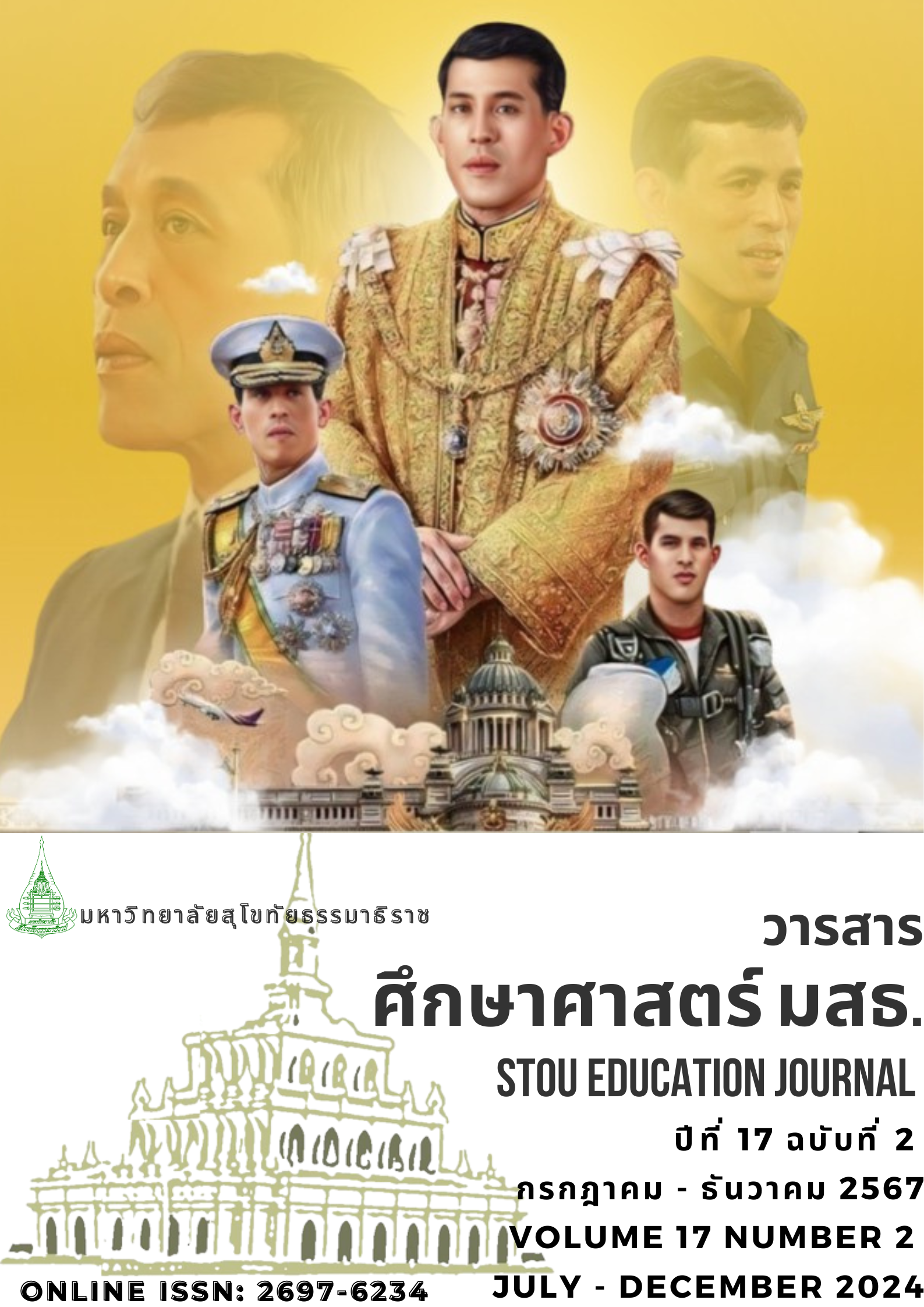การพัฒนาความสามารถในการสร้างคำอธิบายเชิงวิทยาศาสตร์และการสื่อสารทางวิทยาศาสตร์ด้วยการจัดการเรียนรู้โดยใช้บริบทเป็นฐาน เรื่อง สารบริสุทธิ์ ของนักเรียนชั้นมัธยมศึกษาปีที่ 1 โรงเรียนรัตนโกสินทร์สมโภชบวรนิเวศศาลายา ในพระสังฆราชูปถัมภ์ จังหวัดนครปฐม
Main Article Content
บทคัดย่อ
การวิจัยเชิงปฏิบัติการนี้มีวัตถุประสงค์เพื่อ 1) พัฒนาความสามารถในการสร้างคำอธิบายเชิงวิทยาศาสตร์และ ความสามารถในการสื่อสารทางวิทยาศาสตร์ ของนักเรียนชั้นมัธยมศึกษาปีที่ 1 โรงเรียนรัตนโกสินทร์สมโภชบวรนิเวศศาลายาในพระสังฆราชูปถัมภ์ ด้วยการจัดการเรียนรู้โดยใช้บริบทเป็นฐาน เรื่อง สารบริสุทธิ์ และ 2) ศึกษาแนวปฏิบัติที่ดีในการจัดการเรียนรู้โดยใช้บริบทเป็นฐานที่พัฒนาความสามารถในการสร้างคำอธิบายเชิงวิทยาศาสตร์และความสามารถในการสื่อสารทางวิทยาศาสตร์ กลุ่มที่ศึกษา คือ นักเรียน จำนวน 31 คน โรงเรียนรัตนโกสินทร์สมโภชบวรนิเวศศาลายาในพระสังฆราชูปถัมภ์ ได้มาโดยการเลือกแบบเจาะจง เครื่องมือที่ใช้ในการเก็บรวบรวมข้อมูล ได้แก่ แผนการจัดการเรียนรู้โดยใช้บริบทเป็นฐาน จำนวน 6 แผน เวลา 18 ชั่วโมง แบบวัดความสามารถในการสร้างคำอธิบายเชิงวิทยาศาสตร์ แบบประเมินความสามารถในการสื่อสารทางวิทยาศาสตร์ ใบกิจกรรมของนักเรียน วีดิทัศน์การสอน อนุทินสะท้อนความคิดของนักเรียน และบันทึกหลังสอน วิเคราะห์ข้อมูลโดยการหาความถี่ ร้อยละ และวิเคราะห์เนื้อหา ผลการวิจัยพบว่า 1) นักเรียนมีความสามารถในการสร้างคำอธิบายเชิงวิทยาศาสตร์เพิ่มขึ้น นักเรียนส่วนใหญ่อยู่ในระดับดีมาก คิดเป็นร้อยละ 64.52 (จำนวน 20 คน) 2) ความสามารถในการสื่อสารทางวิทยาศาสตร์เพิ่มขึ้น นักเรียนส่วนใหญ่อยู่ในระดับดีมาก คิดเป็นร้อยละ 74.19 (จำนวน 23 คน) และ 3) แนวปฏิบัติที่ดีในการจัดการเรียนรู้โดยใช้บริบทเป็นฐาน มีดังนี้ (1) การใช้คำถามชี้นำและคำถามขยายความช่วยให้นักเรียนสร้างคำอธิบายเชิงวิทยาศาสตร์ (2) การกำหนดบทบาทของนักเรียนที่ชัดเจนในการแลกเปลี่ยนความคิดเห็นช่วยส่งเสริมให้มีข้อกล่าวอ้าง หลักฐาน และให้เหตุผล และ (3) การบันทึกวีดิทัศน์ ร่วมกับการประเมินและสะท้อนจากเพื่อนและครูช่วยส่งเสริมการสื่อสารทางวิทยาศาสตร์ของนักเรียน
Article Details
เอกสารอ้างอิง
จรูญลักษณ์ วรโคตร. (2561). การศึกษาการอธิบายทางวิทยาศาสตร์ของนักเรียนระดับมัธยมศึกษาปีที่ 5 เรื่อง กรด-เบส. วารสารวิชาการการจัดการเทคโนโลยีสารสนเทศและนวัตกรรม, 5(ฉบับพิเศษ), 49-55.
ชุลีณี พาหุรัตน์. (2565). การศึกษาความสามารถในการสร้างคำอธิบายเชิงวิทยาศาสตร์เรื่องโลก ดาราศาสตร์ และ อวกาศ ด้วยการจัดการเรียนรู้แบบบริบทเป็นฐานของนักเรียนชั้นระดับมัธยมศึกษาปีที่ 6. วารสารมหาวิทยาลัยราชภัฏยะลา, 17(3), 148-157.
ธีรพงศ์ พงษ์เสือ. (2564). การพัฒนากิจกรรมการเรียนรู้ SSCS ร่วมกับสถานการณ์ที่ใช้บริบทเป็นฐานเพื่อพัฒนาทักษะการสื่อสารทางวิทยาศาสตร์ของนักเรียนชั้นมัธยมศึกษาปีที่ 4. [วิทยานิพนธ์ปริญญามหาบัณฑิต ไม่ได้ตีพิมพ์]. มหาวิทยาลัยมหาสารคาม.
พัชราภรณ์ บุณยทรรศนีย์. (2558). การพัฒนาทักษะการอภิปรายโต้แย้ง เรื่องแรงและกฎการเคลื่อนที่ ของนักเรียน ชั้นมัธยมศึกษาปีที่ 4 ในการจัดการเรียนรู้โดยใช้บริบทเป็นฐาน. วารสารศึกษาศาสตร์ปริทัศน์, 30(3), 76-85.
วิจารณ์ พานิช. (2555). วิถีการสร้างการเรียนรู้เพื่อศิษย์ในศตวรรษที่ 21. มูลนิธิสดศรีสฤษดิ์วงศ์.
ศศิเทพ ปิติพรเทพิน. (2557). วิทยาศาสตร์กับการสื่อสาร (Science and Communication). เอพริล เรน พริ้นติ้ง .
สถาบันส่งเสริมการสอนวิทยาศาสตร์และเทคโนโลยี . (2560). หนังสือเรียนรายวิชาพื้นฐานวิทยาศาสตร์และเทคโนโลยีชั้นมัธยมศึกษาปีที่ 1 เล่ม 1 (พิมพ์ครั้งที่ 8). สำนักพิมพ์จุฬาลงกรณ์มหาวิทยาลัย.
Bennett, J., Grasel, C., Parchmann, I., & Waddington, D., (2005). Context-based and conventional approaches to teaching chemistry. International Journal of Science Education, 27(13), 1521-1547.
Best, J. W., & Kahn, J. V. (1993). Research in education (8th ed). Allyn and Bacon.
Crawford, M., & Witte, M. (1999). Strategies for mathematics: Teaching in context. Education Leadership, 57, 34-38.
Crawford, L. M. (2001). Teaching contextually: Research, rationale, and techniques for improving student motivation and achievement. Texas: CCI Publishing, Inc
Gilbert, J.K. (2006). On the nature of “context” in chemical education. International journal of Science Education, 28(9), 957-976.
Kemmis, S., & McTagart, R. (1988). The action research planer (3rd ed.). Deakin University.
Kulgemeyer, C., & Schecker, H. (2013). Students explaining science-assessment of science communication competence. Research in Science Education, 43(6), 2235-2256.
McNeill, & Krajcik, J. (2008). Scientific explanations: characterizing and evaluating the effects of teachers’ instructional practices on student learning. Journal of Research in Science Teaching, 45(1), 53-78.


